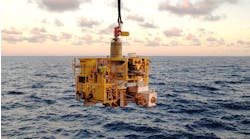I’m happy to announce still another addition to the strengthenedOffshore editorial staff. Ted Moon has joined the magazine as Technology Editor.
Ted comes to us from Nalco Energy Services, where he served most recently as technical marketing manager. In his career at Nalco, he was directed with identifying emerging markets and customer needs, creating and implementing marketing and promotion initiatives, conducting training seminars, and acting as liaison between marketing and R&D on research projects. He wrote a variety of research papers, technical reports and press releases.
Ted has a Bachelor of Science degree in Chemistry and MS and PhD degrees in Chemical Engineering from Penn State University.
AtOffshore, Ted will direct the entire technological content and technical focus of each issue. In addition, he will write and recruit (and sometimes co-author) technical articles, will be heavily involved in the technical content of theOffshorewebsite and technical eNewsletters, and will play a major role in the technical content of existing and new PennWell Petroleum Conferences.
Damage to Gulf of Mexico offshore equipment and operations has been pretty well documented in the daily press, but what will be the near- and long-term effects on the industry from two devastating hurricanes in one month? In this month’s issue,Senior Editor David PaganieandInternational Editor Pam Boscheereview the damage and look ahead at what to expect as the industry recovers and rebuilds. Their extensive report begins onpage 24.
West Africa is well recognized as one of the most active and promising offshore exploration arenas worldwide, but what does the future hold for this growing E&P province? In our West Africa regional report, International Editor Pam Boschee examines the projects under way and appearing on the horizon. Don’t miss her comprehensive report, beginning onpage 36.
By using a novel approach that ties pre-stack seismic and well log data, a team atAnadrako Petroleum Corp., with assistance from theUniversity of Texas-Austin Research Consortium on Formation Evaluation, has built a uniquely detailed 3D model of Anadarko’s Marco Polo field, leading to a better understanding of the vertical and lateral extent as well as the quality of the reservoir.
The new technique yielded a four-fold gain in vertical resolution, and this crispness enabled the team to identify additional features associated with the seismic anomalies, such as small faults and lateral changes in sand quality. For Anadarko, the value extends far beyond the Marco Polo field to other holdings where the method can be used to reduce reservoir development risk and improve drilling and production programs. Their special report forOffshorebegins onpage 54.
There is evidence, in the form of deepwater seismic and recorded gravity data, that the Jurassic (Callovian) salt layer extends under the deepwater portion of the Gulf of Mexico basin between the Sigsbee Knoll salt mass and the Exterior Basin salt mass located north of the Sigsbee Escarpment.
The reclassification of the current basement complex, found in this area of the deepwater Gulf, from igneous to salt, greatly enhances the exploration potential of over 32,000 sq mi of Amery Terrace, Walker Ridge, Lund, Lund South, Atwater Valley, Henderson, and LLoyd Ridge leasing areas. This is an area approximately the size of the state of Maine.Consultant Jack M. Reed discusses the significance of this new finding in a report for Offshore beginning on page 60.
Finally, don’t miss Technology Editor Ted Moon’s preview of the technical papers to be presented at this year’sDeep Offshore Technology Conference. The conference, scheduled for Nov. 8-10 in Vitória, Brazil, continues the tradition of this event by offering attendees a wide selection of enabling technology for deepwater operations.
The scope of this year’s conference includes more than 30 technical sessions, from lessons learned in field development to innovative tieback techniques, from field architecture and economics to new riser technology, and from project execution and management to advanced materials. The preview, beginning onpage 44, provides a sample of the technology mix that will be available at this year’s conference.


